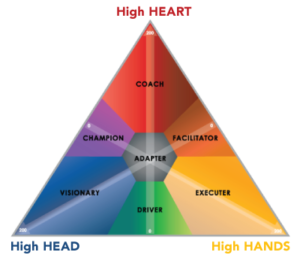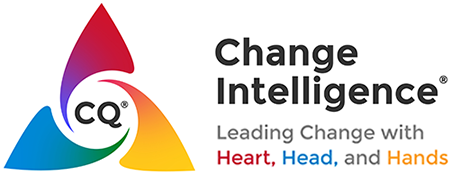Image you are driving down the road in your car, and you start to change lanes. Suddenly you hear a loud “honk,” see another car in the lane you are turning into, and need to quickly swerve to avoid an accident. What happened? You didn’t notice the other car, because it was in your blind spot. You were driving forward, trying to be safe, and needed to change lanes. You checked your rear view mirrors and maybe even glanced a bit sideways. But still you neglected to genuinely ensure that there were no hidden hazards in your path – lurking in your blind spot.
Leadership blind spots are similar. As Change Intelligent leaders know, we each have a dominant style of leading change. Some focus on the “purpose” – the “head” – and are visionary and strategic. Some focus on the “process” – the “hands” – and are planful and tactical. Some focus on the “people” – the “heart” – and are engaging and collaborative.
Of course just as each of us has a head, heart, and most of us have hands, all of us can and at times do direct our energies on all these three critical aspects of leading change. Yet, our dominant tendency is our strength, our “go-to” leadership style. Our style is our preferred mode of thinking and acting – and is what makes us successful.
Nevertheless, leveraging our strengths can cause us to lose focus on other critical aspects of the change process. We can miss, neglect, or downplay – even be literally blind to – important issues and opportunities that need to be paid attention to in order to lead others towards demanding new objectives.
By picturing the Change Leader Styles on a triangle, we can see that what is on the opposite side of the triangle from our style is our blind spot.
 For example, I am the Champion style, the blend of “heart” and “head.” I get where the change needs to go, and I enjoy motivating the people to get there. However, my blind spot is the Executional “hands.” I can miss, downplay, and neglect detailed planning, assessment of issues and risks, and structured follow-up.
For example, I am the Champion style, the blend of “heart” and “head.” I get where the change needs to go, and I enjoy motivating the people to get there. However, my blind spot is the Executional “hands.” I can miss, downplay, and neglect detailed planning, assessment of issues and risks, and structured follow-up.
Since I’m aware of this blind spot, what can I do?
Indeed, this is one of the foundational opportunities of building Change Intelligence, defined as “the awareness of one’s own Change Leader Style, and the ability to adapt one’s style to be optimally effective across a variety of people and situations.”
To keep our blind spots “on the radar screen,” try these three tactics:
- Partner with people – Team with others in areas you are weaker or don’t enjoy. For example, my favorite co-facilitator is a very strong Executer. He helps keep me grounded, centered, and finishing strong.
- Build muscle – Actively take on improving your developmental areas. For example, I have taken project management training to get better at executional tasks. I have not enjoyed it – it feels like driving a car with the brakes on – but I’ve benefited from it tremendously.
- Put systems and structures in place – Leverage tools and processes that will remind you to focus on key areas that you might unintentionally drop out – don’t leave it to good intentions. For example, I use project planning spreadsheets to make sure I am keeping track of tasks and accountabilities to keep myself and my partners in change aligned and on track.
Note that these same three tactics can be used with teams, just like with individuals. First, change teams that lack a critical Change Leader style can intentionally add members, or rely on ad hoc advisors who have the missing propensity. Second, teams can also schedule themselves for training and team-building to build collective capacity. Finally, teams can use systems and structures just like people can, for example incorporating process checks in to their agendas, deploying tools from the change management toolkit, etc.
